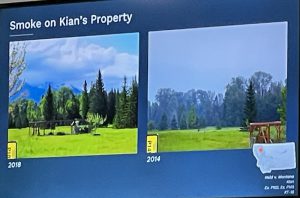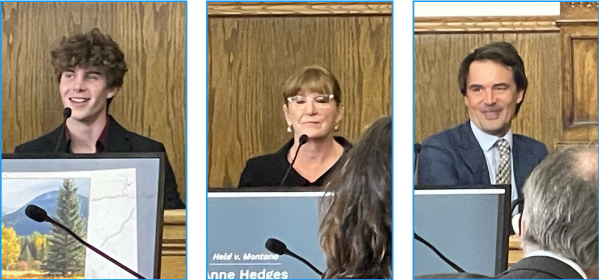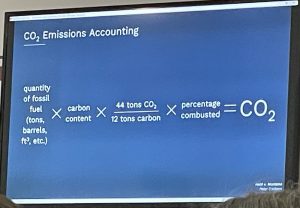GAFTG Founder Maya van Rossum is in Montana giving live coverage of the trial from her perspective as a national expert on constitutional environmental rights. Read her breakdown of the most poignant moments in the courtroom from the trial:
Day 4 of the trial delved heavily into law and numbers.
But first, the day began with some much needed grounding and inspiration. Youth plaintiff Kian Tanner who talked passionately about his time in Montana’s nature, including describing a day in Glacier National Park, standing on a rock with his arms spread, and the wind rushing closely around his body: “I felt free and connected to every part of nature.” It was a ground and beautiful way to start the day’s testimony.
Next came Anne Hedges, a 30 year advocate with the Montana Environmental Information Center – aka MEIC – the organization who brought the first landmark case where the Montana Supreme Court, in 1999, made clear that Montana’s Green Amendment was passed and was to be both interpreted and applied in a substantive and meaningful way to protect the promised environmental rights of present future generations. It was in this MEIC v. Montana DEQ when the court eloquently ruled:
“Our constitution does not require that dead fish float on the surface of our state’s rivers and streams before its farsighted environmental protections can be invoked.”
Ms. Hedges conveyed to the audience, state and court the importance of Montana’s constitutional language, and the importance of the Montana Environmental Protection Act – MEPA – which requires Montana’s government to fully consider the environmental impacts of proposed government action, including consideration of alternatives – for ensuring government action fulfilled the state’s constitutional obligations. Ms. Hedges powerfully ended her testimony:
“Montana is running in the wrong direction with regards to the climate crisis. State government has no interest in these youth plaintiffs and their right to a clean and healthful environment. The only thing that will make Montana change is—”
“Objection!” the state called out.
Anne was unable to finish her thought. But I think she was about to say is, “…an order from the court.”

Youth plaintiff Claire Vlases, now a part time ski instructor and runner, shared with the court that when she was young her parents were told she may never walk. But 10 years of physical therapy got Claire on her feet and walking. At 10, the insurance company took away her therapy, and so Claire turned to nature to continue to keep and build her physical strength. And so weather changes and wildfire smoke that limit her physical activity in nature has a particularly poignant impact on Claire and her ongoing physical health.
Claire shared, “When I heard Mr. Doyle testify that he does not ever remember smoke in his Montana childhood, I nearly fell out of my chair, because I don’t remember a single summer in Montana that didn’t involve smoke.”
The day ended with expert Peter Erickson from the Stockholm Environmental Institute who educated us about the sheer volume of CO2 Montana releases to the environment because of fossil fuels: 166 million tons.
Frighteningly Erickson shared a graphic that demonstrated that to date “Montana has only scratched the surface of the fossil fuels that exist in the state.” Untapped and still under the service of the earth in “reserve” is an additional 707 million tons of coal; 289 million barrels of oil and 613 billion cubic feet of gas.
While the state tried to minimize this volume of greenhouse gas emissions but suggesting it paled in comparison to the international volume of CO2 released. Erickson was firm and compelling, quoting the IPCC: “every tonne of CO2 emissions adds to global warming.” Erickson emphasized that comparing Montana’s contribution to the global condition does not change the fact: Montana’s contribution has an impact that could be addressed by changed government action.
The laugh of the day?
When Erickson was asked to address the Montana’s claim that it should be given credit for the CO2 releases from clean energy produced in the state, and the avoided emissions should “offset” the CO2 emissions released from the state’s fossil fuel activities Erickson responded:
This definition of offset does not work. It’s like saying that if in my house there were two pieces of cake. I ate one of the piece of cake in the living room. But I didn’t eat the piece of cake in the kitchen. When I added it up, the piece of cake offset by the piece of cake not eaten would add up to eating zero cake that day!
It makes no sense.
It simply doesn’t work that way.
The room erupted into laughter.
*For clarity:
The piece of cake eaten represents the CO2 emissions actually released.
The piece of cake not eaten represents CO2 emissions not released.
The state’s expert was trying to say that the emissions avoided by clean energy should cancel out the emissions that were in fact released.
But the reality is that fossil fuels are releasing CO2 to the atmosphere – just because you reduced that number by creating some energy with renewable options does not cancel out, in reality, what was released.
